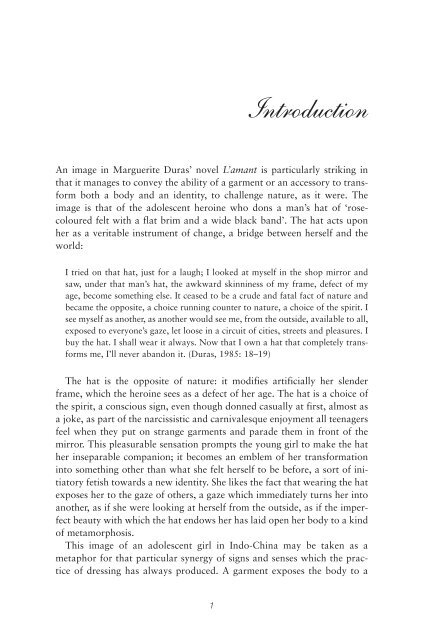You also want an ePaper? Increase the reach of your titles
YUMPU automatically turns print PDFs into web optimized ePapers that Google loves.
Introduction<br />
An image in Marguerite Duras’ novel L’amant is particularly striking in<br />
that it manages to convey the ability of a garment or an accessory to transform<br />
both a body and an identity, to challenge nature, as it were. <strong>The</strong><br />
image is that of the adolescent heroine who dons a man’s hat of ‘rosecoloured<br />
felt with a flat brim and a wide black band’. <strong>The</strong> hat acts upon<br />
her as a veritable instrument of change, a bridge between herself and the<br />
world:<br />
I tried on that hat, just for a laugh; I looked at myself in the shop mirror and<br />
saw, under that man’s hat, the awkward skinniness of my frame, defect of my<br />
age, become something else. It ceased to be a crude and fatal fact of nature and<br />
became the opposite, a choice running counter to nature, a choice of the spirit. I<br />
see myself as another, as another would see me, from the outside, available to all,<br />
exposed to everyone’s gaze, let loose in a circuit of cities, streets and pleasures. I<br />
buy the hat. I shall wear it always. Now that I own a hat that completely transforms<br />
me, I’ll never abandon it. (Duras, 1985: 18–19)<br />
<strong>The</strong> hat is the opposite of nature: it modifies artificially her slender<br />
frame, which the heroine sees as a defect of her age. <strong>The</strong> hat is a choice of<br />
the spirit, a conscious sign, even though donned casually at first, almost as<br />
a joke, as part of the narcissistic and carnivalesque enjoyment all teenagers<br />
feel when they put on strange garments and parade them in front of the<br />
mirror. This pleasurable sensation prompts the young girl to make the hat<br />
her inseparable companion; it becomes an emblem of her transformation<br />
into something other than what she felt herself to be before, a sort of initiatory<br />
fetish towards a new identity. She likes the fact that wearing the hat<br />
exposes her to the gaze of others, a gaze which immediately turns her into<br />
another, as if she were looking at herself from the outside, as if the imperfect<br />
beauty with which the hat endows her has laid open her body to a kind<br />
of metamorphosis.<br />
This image of an adolescent girl in Indo-China may be taken as a<br />
metaphor for that particular synergy of signs and senses which the practice<br />
of dressing has always produced. A garment exposes the body to a<br />
1

















